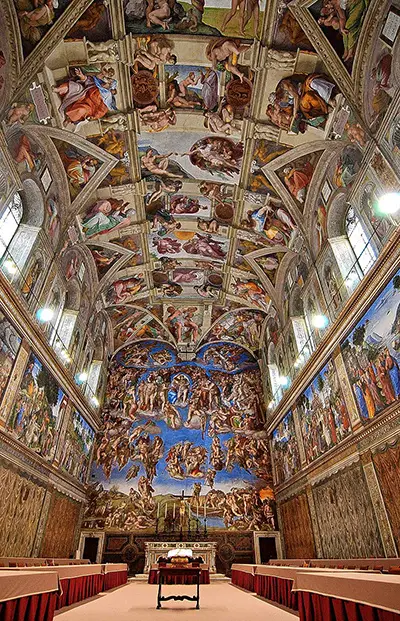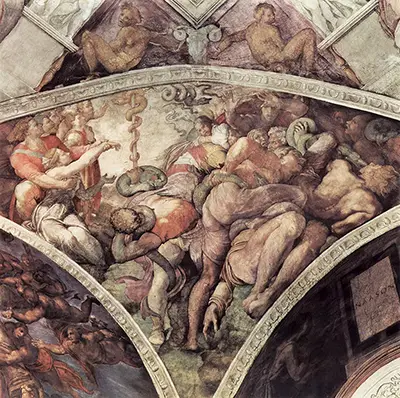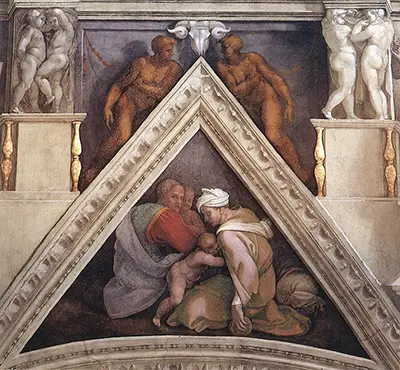Anyone who has had the opportunity to see the chapel's ceiling up close must have noticed two things. One, that ceiling is high, and it is certainly filled with a lot of paintings. It is hard to imagine that one artist was able to do all that in under five years, and in a way, this knowledge brings the picture of Michelangelo to mind as he lay on his back and toiled away from one year to the next. There is little doubt that he knew his ceiling would become one of the most important in history, but then again Michelangelo was an extremely talented artist.
At first, the painter was instructed to paint a sort of geometric symbol to replace the then blue Chapel ceiling that was dotted with stars. This was back in 1508 when Michelangelo was under the commission of Pope Julius II. Instead, the artist chose to decorate the ceiling with the Old Testament scenes that the world knows and appreciates today.
Description of the Frescos
The frescoes are more than just mere decorations meant to impress the eye. These scenes tell a story – the story of mankind right from the very start. They tell the story that existed before all other stories came along – the story of creation. Divided into three sections, the scenes are arranged in chronological order with the first part of the narrative painted over the altar. Here, one will find three paintings – The Creation of Heavens and Earth, The Creation of Adam and Eve, and lastly The Expulsion from the Garden of Eden. Michelangelo then effortlessly follows up with a painting of Noah and the Great Flood.
He tells the same old story to the world, but the painter captures more in his frescos that anyone could ever imagine. By using ignudi (nude youth) to represent his message, Michelangelo preaches the message of the birth of Christ and finds a way to relate it to the creation of man.
The Techniques Used
Most of his paintings have narrative details as they show multiple figures all painted in small sizes. This makes one particular fresco stand out from all the rest – The Creation of Adam. In this fresco, the figures are monumental as they stretch out to meet each other across a void. The fact that it differs from the rest could be what makes the painting stand out from the rest, but despite the fact that it lacks narrative, the detail in this picture is still outstanding. Michelangelo's painting of The Deluge includes much more detail. Here, he paints the sky and the waters and uses the space available to him to portray four narratives.
The painting shows a cluster of people trying to avoid the rain by taking shelter under a makeshift object. On the left side are more people who are running up a mountain to try and get away from the rising waters. At the centre of the picture is a boat that seems to be overcome by the combined power of the rain and the raging sea. In the background of this picture, however, is salvation as a small team works to complete the building of the Ark. This picture shows tragedy, but there is a single ray of hope for the future of man. Those about to die are desperate and call for an observer's sympathy.
The picture makes one rethink the justice of God as he resorted to wiping out the entire world so that it could start all over again. But in saving Noah and his family, Michelangelo paints the salvation of God in its true form. There is another detail that is clear when the Sistine Chapel ceiling is observed up close. It is like there are two different sections that were painted by two different artists. This is probably because, during his labour, Michelangelo took a one year break in 1510. In images like The Deluge, we can see that the people are perishing in flood, but it is hard for one to make out their emotional state. By painting a cluster of people in a tight space, Michelangelo sacrificed any connection that might have been forged between an observer and those characters in his painting.
His later work uses more monumental figures that have clear faces and clear features, making it easier for people to connect with the paintings. Taking the Creation of Adam, for instance, we find that we can make out Adam's face to be lazy and relaxed with a slight sense of yearning. We can also make out the face of God to be serious as if he is hard at work in making his creation. One can perceive this even from the floor of the chapel. There is a little detail, but really, the superiority of Michelangelo's work after he took his break lies in the simplicity that he came to employ.
The Connection Observable in His Paintings
The paintings focus on the story that has been told in the book of Genesis, but there are forms that have been interpreted to portray the image of the Christ child. In the Creation of Adam, this child figure has been included to mean that even if man is created in the image and likeness of God, there is still room for sin and that God foresaw this sin. The frescos connect the Old Testament to the New Testament in a way that had never been done before. Michelangelo found a way to put this connection into art. He found a whole new way of presenting the scenes from the Bible, including the idea that Adam was brought to life through the simple touch of God's finger.
In an attentive order, the painter silently narrates the tale of Adam from the perfection that he was during creation to the sinner that his children became after the fall of mankind. There are nine narrative paintings on this ceiling, but the perspective used on the subjects is on a point that if one looks closely enough, they can almost see the figure rearing out of the ceiling wall. The characters used are ancient, yes, but after viewing these images, observers go out into the real world with vivid imaginations of what was and what is.
Michelangelo breached the gap between the past innocence, the present sinfulness, and the future redemption of mankind, making it all seem like one continuous story when it was in fact realised in centuries. It is possible that the painter's mind did not quite extrapolate this far when he was toiling away at the ceiling, but the idea just seems to fit so much that one cannot help but imagine what Michelangelo was thinking – imagine how the world would interpret his final masterpiece.
What was Michelangelo's Motivation?
It is not clear what inspired him to paint the ceiling, in fact, one might say that Michelangelo was anything but inspired when he started decorating the Sistine Chapel. Pope Julius II practically forced him to do it, so in a way, the Pope was his inspiration. The country during that time had been broken by war, and in an attempt to unite the people once again, the Pope saw it fit to have the chapel ceiling and walls repainted. The ceiling was meant to inspire divine servitude, so by using the power granted to the church, the Pope commissioned Michelangelo to paint 12 frescos that showed images of the 12 apostles of Christ.
These apostles were supposed to be painted in a geometric fashion. The painter was not inspired by this original commission, so he proposed that the scenes from the Old Testament story of creation be painted instead. He knew that the apostles of Christ had led poor lives and, therefore, hesitated to paint them in the glories of the world. This painter liked a challenge, and to him, painting 12 figures over such a big space didn't present much of a challenge. He instead opted to paint the 300 or so complex figures that now dominate the chapel ceiling.
It is said that a number of people, including the Pope's cousin Marco Vigerio Della Rovere inspired the design of the Sistine Chapel ceiling, but this is just a theory. As one enters the chapel, the images of the rise of mankind are painted in reverse. This has been interpreted to mean that as one moves closer to the altar, they are moving closer to the glory of God – moving closer to his salvation.
At the entrance, one can see Noah in his drunkenness, and at the altar, one can see God as he separates the light from the dark. As an observer walks down to the altar, the story tells itself in reverse, and the very centre of the ceiling one can see God as he gives life to the first man, Adam. Painting these frescoes permanently damaged Michelangelo's spine, and while it might have been easy for him to paint the figures, it must have been difficult for him to give these figures the voice that they still pose even to this day.
The reversed order in which the frescoes are painted is, in a way, symbolic. Going towards the altar is going towards God and the rise of mankind, but going away from the altar and back into the outside world represents a walk that leads to the sinfulness and eventual fall of mankind.
The Style Used
The high-key colours used by the painter are extremely helpful to anyone who hopes to decipher the contents of the Sistine Chapel from 60 feet below. The colours are now brash and bright as compared to how they were before the ceiling was restored. There is a general white backdrop that brings out the yellows, the pinks, and the greens that the painter used to paint his characters to life. The use of old prophets and ancient sibyls has been interpreted in different ways over the years.
Sibyls foretold the birth of a saviour in the ancient times, but for the modern Christian, the birth of Christ was foretold by ancient prophets in the Old Testament. Michelangelo used sibyls and prophets to point to the same salvation that would be afforded to the entire human race. He paints one particular Sibyl in an interesting fashion, Libyan Sibyl. She is made to appear in the form of sculpture, much like all the characters that this artist portrayed. This sibyl's body is somewhat twisted as she sits on a garment looking over her shoulder towards the direction of the altar. Her image seems to fit perfectly in the environment that it has been placed.
There are triangular panels that are placed to the side of the central chapel panels. Within these triangular panels are figures that represent the ancestors of Christ. Separating these panels are representations of five sibyls and the seven prophets. The four corners of the chapel show four scenes inspired by the Old Testament. After he had finished painting Noah's drunkenness, Michelangelo looked at the images again, and after realising that they were not as imposing as he had intended, he opted to make them grander. So, as one walks towards the altar, the images become larger and larger. His work is religious in all fronts. The paintings, especially the deep sense of emotion evident in some of the character's faces, are a proof of Michelangelo's piety.
Finally came the Last Judgement that Michelangelo created 20 years after he had finished all the other paintings on the ceiling. This last image is located on the altar wall of the Sistine Chapel, and comparing how it was made versus how all the other images were made to appear, one can begin to understand why not much thought is given to it by observers. The talent employed in this picture is just as outstanding, but the Last Judgement carries around a concept of bleakness. This painting shows the second coming of Christ, and although the inspiration comes from the Bible, the artist used his vivid imagination to create the radiant picture filled with saints and angels. This painting shows the ultimate end of the human race after centuries of sin and disobedience.
The reason that most observers have deemed it to be a show of hopelessness is that Christ is seen to be plunging a majority of people into the damned fires of hell, it is only a few that are rising into heaven. Some figures are cowering before the son of God as he passes his final judgement. The images are somewhat disturbing and very realistic as the Saint Bartholomew holds out his skin and the Saint Andrew holding the cross that he was crucified on.
Michelangelo was to art what Shakespeare was to literature. These two characters in history represented new ideas. The painter tried to push forth a new idea of what was meant to be. Through these images, the religious world view he had becomes clear to the world. Michelangelo painted not to blind us to his perspective, but to give us a glimpse into his mind – into the world that he imagined. He painted and left his work free of interpretation, giving any observer the chance to drink in this marvellous creation and make their conclusions.
Right from the entrance of the chapel, the painter shows us a vision of what it was like for a man to meet the touch of God during creation. He shows us this in a bold and energetic way, using images of ancient prophets and seers to include the concept of the future. Looking at the Sistine Chapel ceiling is looking directly at the divine not through the eyes of Michelangelo, but through those of every human being ever created. These paintings are not limited by what has been preached, and they go beyond the rules that have been set about religion and fully express an idea of God that most people could not dare imagine.
More than 500 years down the line and the modern world is still in awe each time we look at Michelangelo's creation. After the chapel was cleaned, the real complexity of the artist's palette was exposed, and since then, the Sistine Chapel has become some school and inspiration for everyone around the world. At 33, this artist unwillingly started out on this commission to paint the pope's private chapel only for it to become the best thing he ever created. For a sculptor who insisted that he was not a painter, the work he did on the Sistine Chapel ceiling comes awfully close to perfect.
The period of 1508-1512 represented a key time in the career of Michelangelo as he set about constructing an array of frescos across the ceiling of the Sistine Chapel.
This monumental task was to be completed with such immense creativity and technique that the artist himself was to become a household name from then on.
Certain specific elements of the overall piece are considered masterpieces in their own right, and to see them all together is truly extraordinary.
The popularity of Michelangelo's work is also shown in the fact that he was invited back some years later to complete The Last Judgement painting which sat on the altar wall, close to his previous work.
Michelangelo was an artist with huge confidence as well as technical ability which was necessary in order to take on such a challenging request, which had come from Pope Julius II.
The complex combinations of figures across the ceiling has helped many budding artists to understand the true skills of the artist in capturing the human body in a manner of different ways. His understanding of anatomy was impressive and necessary to produce such lifelike and believable portraits.
All of Michelangelo's work on the ceiling is now over 500 years old and so it has been very necessary to continuously protect the frescos and plaster work from all natural elements as well as enthuastic tourists who have been flocking to the Chapel for centuries.
There have also been restorative work in recent generations to remove darkening effects from natural elements that can never be entirely guarded against. The nature of this large artwork also means that it is harder to look after than a normal sized standard painting or sculpture.
The art within the Sistine Chapel, which also includes work by many other notable Italian artists, underlines the wealth and status of the Pope and Christianity itself at that time. Quite simply, it could attract and afford commissions with the finest artists of that time and Michelangelo was clearly around the top of that list.









